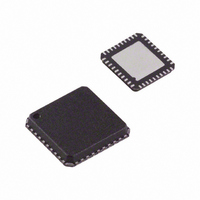ADV3003ACPZ Analog Devices Inc, ADV3003ACPZ Datasheet - Page 13

ADV3003ACPZ
Manufacturer Part Number
ADV3003ACPZ
Description
IC,Cable Equalizer,LLCC,40PIN,PLASTIC
Manufacturer
Analog Devices Inc
Datasheet
1.ADV3003ACPZ-R7.pdf
(16 pages)
Specifications of ADV3003ACPZ
Applications
DVI, HDMI Equalizer/Driver
Interface
TMDS
Voltage - Supply
3 V ~ 3.6 V
Package / Case
40-LFCSP
Mounting Type
Surface Mount
Lead Free Status / RoHS Status
Lead free / RoHS Compliant
Lead Free Status / RoHS Status
Lead free / RoHS Compliant
Available stocks
Company
Part Number
Manufacturer
Quantity
Price
Company:
Part Number:
ADV3003ACPZ
Manufacturer:
Analog Devices Inc
Quantity:
135
Company:
Part Number:
ADV3003ACPZ
Manufacturer:
TI
Quantity:
30
Part Number:
ADV3003ACPZ
Manufacturer:
ADI/亚德诺
Quantity:
20 000
The ADV3003 buffers the TMDS signals; therefore, the input
traces can be considered electrically independent of the output
traces. In most applications, the quality of the signal on the input
TMDS traces is more sensitive to the PCB layout. Regardless of
the data being carried on a specific TMDS channel, or whether
the TMDS line is at the input or the output of the ADV3003, all
four high speed signals should be routed on a PCB in accordance
with the same RF layout guidelines.
Layout for the TMDS Signals
The TMDS differential pairs can either be microstrip traces,
routed on the outer layer of a board, or stripline traces, routed
on an internal layer of the board. If microstrip traces are used,
there should be a continuous reference plane on the PCB layer
directly below the traces. If stripline traces are used, they must
be sandwiched between two continuous reference planes in the
PCB stack-up. Additionally, the p and n of each differential pair
must have a controlled differential impedance of 100 Ω. The
characteristic impedance of a differential pair is a function of
several variables including the trace width, the distance separating
the two traces, the spacing between the traces and the reference
plane, and the dielectric constant of the PC board binder material.
Interlayer vias introduce impedance discontinuities that can
cause reflections and jitter on the signal path; therefore, it is
preferable to route the TMDS lines exclusively on one layer of the
board, particularly for the input traces. In addition, to prevent
unwanted signal coupling and interference, route the TMDS
signals away from other signals and noise sources on the PCB.
Both traces of a given differential pair must be equal in length
to minimize intrapair skew. Maintaining the physical symmetry
of a differential pair is integral to ensuring its signal integrity;
excessive intrapair skew can introduce jitter through duty cycle
distortion (DCD). The p and n of a given differential pair should
always be routed together to establish the required 100 Ω
differential impedance. Enough space should be left between
the differential pairs of a given group so that the n of one pair
does not couple to the p of another pair. For example, one tech-
nique is to make the interpair distance 4× to 10× wider than the
intrapair spacing.
Any group of four TMDS channels (input or output) should
have closely matched trace lengths to minimize interpair skew.
Severe interpair skew can cause the data on the four different
channels of a group to arrive out of alignment with one another.
A good practice is to match the trace lengths for a given group
of four channels to within 0.05 inches on FR4 material.
The length of the TMDS traces should be minimized to
reduce overall signal degradation. Commonly used PC board
material such as FR4 is lossy at high frequencies, so long traces
on the circuit board increase signal attenuation, resulting in
decreased signal swing and increased jitter through intersymbol
interference (ISI).
Rev. 0 | Page 13 of 16
Controlling the Characteristic Impedance of a TMDS
Differential Pair
The characteristic impedance of a differential pair depends on
a number of variables including the trace width, the distance
between the two traces, the height of the dielectric material
between the trace and the reference plane below it, and the
dielectric constant of the PCB binder material. To a lesser
extent, the characteristic impedance also depends upon the
trace thickness and the presence of solder mask.
Many combinations can produce the correct characteristic imped-
ance. It is generally required to work with the PC board fabri-
cator to obtain a set of parameters to produce the desired results.
One consideration is how to guarantee a differential pair with a
differential impedance of 100 Ω over the entire length of the
trace. One technique to accomplish this is to change the width
of the traces in a differential pair based on how closely one trace
is coupled to the other. When the two traces of a differential
pair are close and strongly coupled, they should have a width
that produces a 100 Ω differential impedance. When the traces
split apart, for example, to go into a connector, and are no
longer so strongly coupled, the width of the traces should be
increased to yield a differential impedance of 100 Ω in the new
configuration.
Ground Current Return
In some applications, it may be necessary to invert the output
pin order of the ADV3003. This requires routing of the TMDS
traces on multiple layers of the PCB. When routing differential
pairs on multiple layers, it is also necessary to reroute the corres-
ponding reference plane to provide one continuous ground
current return path for the differential signals. Standard plated
through-hole vias are acceptable for both the TMDS traces and
the reference plane. An example of this routing is illustrated in
Figure 27. To lower the impedance between the two ground
planes, additional through-hole vias should be used to stitch the
planes together, as space allows.
SILKSCREEN
LAYER 1: SIGNAL (MICROSTRIP)
PCB DIELECTRIC
LAYER 2: GND (REFERENCE PLANE)
PCB DIELECTRIC
LAYER 3: PWR
(REFERENCE PLANE)
PCB DIELECTRIC
LAYER 4: SIGNAL (MICROSTRIP)
SILKSCREEN
Figure 27. Example Routing of Reference Plane
KEEP REFERENCE PLANE
ADJACENT TO SIGNAL ON ALL
LAYERS TO PROVIDE CONTINUOUS
GROUND CURRENT RETURN PATH.
THROUGH-HOLE VIAS
ADV3003









